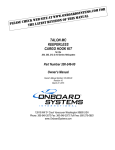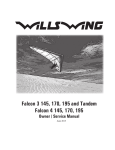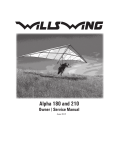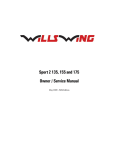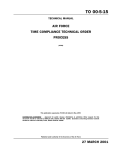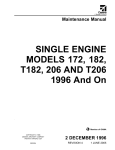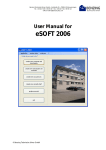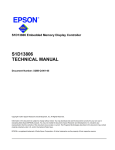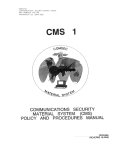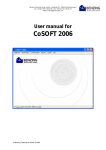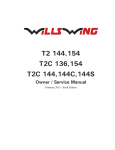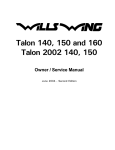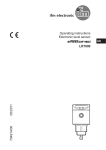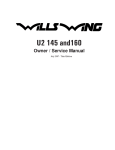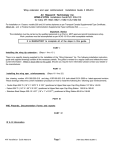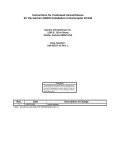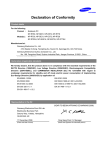Download CGTO PG-85-00-40 TC~3505~
Transcript
U.S. Department of Homeland Security United States Coast Guard TCTO/SCTO PROCESS GUIDE CGTO PG-85-00-40 This CGTO PG-85-00-40 dated 2 November 2007 supersedes CGTO PG-85-00-40 dated 1 August 2006 in its entirety. Destroy all previous editions. 2 NOVEMBER 2007 CGTO PG-85-00-40 TABLE OF CONTENTS CHAPTER 1 COAST GUARD TCTO A. PROCESS . . . . . . . . . B. TRACKING . . . . . . . . . . . . . . . . . . . . . . . . . . . . . . . . . . . . . . . . . . . . . . . 1- 1 1- 4 CHAPTER 2 COAST GUARD MESSAGE TCTO A. PROCESS . . . . . . . . . . . . . B. TRACKING . . . . . . . . . . . . . . . . . . . . . . . . . . . . . . . . . . . . . . . . . . . . . 2- 1 2- 2 CHAPTER 3 COAST GUARD SPECIAL COMPLIANCE TECHNICAL ORDER (SCTO) A. PROCESS . . . . . . . . . . . . . . . . . . . . . . . . . . B. TRACKING . . . . . . . . . . . . . . . . . . . . . . . . . . . . . . . . 3- 1 3- 1 CHAPTER 4 TCTO/SCTO GUIDELINES A. GUIDELINES . . . . . . . . . . . . 4- 1 . . . . . . . . . . . . . . . . ENCLOSURE INDEX Enclosure (1) SAMPLE TCTO/SCTO Enclosure (2) TCTO/SCTO PROCESS DIAGRAM Enclosure (3) TCTO/SCTO NUMBER REQUEST AND TRACKING FORM Enclosure (4) REQUIREMENTS FOR ACCB APPROVAL Enclosure (5) TCTO/SCTO FINAL VERSION COORDINATION SHEET Enclosure (6) TCTO/SCTO CHAPTER CATEGORY Enclosure (7) TCTO/SCTO TRACKING UPDATE SCREEN Enclosure (8) AIRCRAFT COMPREHENSIVE TCTO/SCTO TRACKING REPORT Enclosure (9) INSTRUCTIONS FOR MESSAGE TCTO PREPARATION Enclosure (10) MESSAGE TCTO FLOW CHART Enclosure (11) HOW TO DETERMINE APPROPRIATE ADDRESS i . . CGTO PG-85-00-40 CHAPTER 1. A. COAST GUARD TCTO PROCESS 1. 2. 3. General Description a. This guide was developed as an aid for the person who originates, reviews, and approves or rejects a Time Compliance Technical Order (TCTO). TCTOs generally require a physical change to an aircraft or a special, urgent, or repeated inspection, requiring compliance within specified time limits. b. When a vendor is contracted to write a TCTO due to a special project, the contract shall specify that, upon request, the vendor shall be provided a Microsoft Word TCTO template for use to complete the draft TCTO. Once work is complete on the project and the contract deliverable is accepted by the Contracting Officer, it shall be routed as a final draft to ARSC ESD Technical Publications Branch. c. The process flow of the TCTO is described here to eliminate confusion about its disposition. All reviewers should be aware that bottlenecks in the process lie at the various process review points. The speed that a TCTO becomes a change in an aircraft system (resulting in ultimate satisfaction of the customer) is dependent upon the time it takes to process and forward the TCTO to the succeeding review point. Reviewers should try to minimize this time as much as possible. d. The process flow for a revised TCTO is the same as the original TCTO except a revision TCTO must be reviewed by the ACMS Senior Analyst before the TCTO goes to print. If any additions or corrections are required to a published TCTO, a revised TCTO will be published. The revised TCTO is published in its entirety with all changes identified by revision bars. Revisions to existing TCTOs will be identified by the basic TCTO number, followed by a sequential number, depending on the number of times the directive has been revised. For example, the third revision to TCTO T67140 would be TCTO T67143. References a. This Process Guide is referenced in the Aeronautical Engineering Maintenance Management Manual, COMDTINST M13020.1 (series). b. Refer to CGTO PG-85-00-90, Project Officer Management Guide for guidance when a project requires a TCTO. c. Refer to CGTO PG-85-00-70, Aircraft Configuration Control Board Process Guide, for more information on TCTOs that require ACCB approval. d. Refer to CGTO PG-85-00-20, Process Guide/User Manual for the CG-22 Tracking System, for guidance on the use of the CG-22 Tracking System. e. Enclosure (1) is a sample TCTO to be used as a guide when developing and reviewing a TCTO. The TCTO/SCTO Template, TCTO/SCTO Number Request, Template Instructions, and the TCTO/SCTO Process Guide can be downloaded from the web at http://cgweb.arsc.uscg.mil/eisd/tcto/index.cfm. The ACCB Item Record Template can be downloaded from the web at http://cgweb.arsc.uscg.mil/eisd/content/accb/accb.cfm. Detail of the Process Refer to Enclosure (2) for a diagram of the TCTO/SCTO process. a. The TCTO process starts with an idea. The idea can originate from many sources. The examples in Enclosure (2) are not inclusive. The ideas can be conveyed in many forms; most often by suggestions from the field, aviation mishaps, Service Bulletins, and other organization’s TCTOs. It may be initiated from an Unsatisfactory Report for an affected part, an aircraft accident, a supervisor in the overhaul line, or parts reliability data. NOTE Anyone in the Aeronautical Engineering System can raise an issue that starts the TCTO process. 1-1 CGTO PG-85-00-40 b. ARSC informs the CG-41 System Manager when the TCTO will possibly impact or ground the fleet. CG-41 can disapprove the idea or agree that the TCTO be developed. This may be done by telephone, e-mail, or Fax correspondence between the appropriate ARSC Product Line Division (PLD) Engineering Cell, Engineering Services Division (ESD), and CG-41 only. c. If ACCB (Aircraft Configuration Control Board) Phase 1 is not required by CG-41, proceed to paragraph 1.A.3.e. If ACCB Phase 1 is required, the ACCB evaluates the new proposal at its next meeting and the voting members will make a Phase 1 determination. Refer to CGTO PG-85-00-70, Aircraft Configuration Control Board Process Guide. ACCB records can be viewed at http://cgweb.comdt.uscg.mil/g-sea/ACCB/index.htm. d. If ACCB Phase 1 approval is obtained, CG-41 will task ARSC to evaluate the proposal and develop a prototype. If an operational evaluation or kit proofing is required, ARSC will task the appropriate Prime Unit. If Prime Unit cannot conduct the operational evaluation or kit proofing, CG-41 or CG-711 will task an air station. e. If a TCTO is developed, a TCTO number will be assigned. This number will be assigned at the request of the appropriate ARSC PLD Engineering Cell only. A TCTO/SCTO Number Request and Tracking Form, Enclosure (3), must be filled out. The sequentially indexed and unique TCTO number is obtained from ARSC ESD Technical Publications Branch (TPB), using the Aviation Computerized Maintenance System (ACMS) TCTO/SCTO numbering function. All data entered into ACMS is entered by ARSC ESD TPB, except the Maintenance Requirement List (MRL) date, which is entered by the ACMS Maintenance Analyst. f. The appropriate ARSC PLD Engineering Cell submits a draft of the TCTO to ARSC TPB. g. TPB reviews and edits TCTO, puts TCTO in proper format, and forwards draft copy of TCTO to the author for their review and signoff. h. Draft copy of TCTO is reviewed by the ACMS Maintenance Analyst. i. Draft copy of the TCTO, along with applicable Supply Item Change Requests (SICRs), are forwarded to the appropriate PLD Supply Cell. Draft copy of TCTO is reviewed by the PLD Supply Cell Equipment Specialist, the Supply Cell Leader, and the Inventory Manager (IM). Parts are then ordered for the prototype by the appropriate PLD Supply Cell Equipment Specialist. If applicable, CFT reviews TCTO. j. The draft copy is returned to the Technical Writer to make any changes that may have been marked. k. Draft copy of TCTO is given to the TPB Editor for review and signoff. l. Draft copy of TCTO is reviewed by the Pollution Prevention Coordinator (ARSC Facility’s Manager) to verify that all chemicals used are on the applicable Authorized Chemical List (ACL). m. Draft copy of TCTO is reviewed and signed off by the ARSC Weight and Balance Official for verification of weight and balance changes. n. If applicable, the draft TCTO is reviewed by the Aircraft Wiring Configuration Control Manager. o. When directed by ARSC, the prototype installation is performed to verify kit contents and installation instructions prior to distribution. The prototype is analyzed for feasibility. Corrections to the kits are addressed. Prime Units are often requested to prototype a change and prepare the TCTO. The draft TCTO/evaluation report is then forwarded to ARSC for review. 1-2 CGTO PG-85-00-40 p. When ACCB Phase 2 is not required, refer to paragraph 1.A.3.s. If ACCB Phase 2 is required, the appropriate ARSC PLD Engineering Cell will forward a recommendation along with the draft TCTO to the ACCB Coordinator via Chief, ESD, with an information copy to the appropriate Prime Unit. q. The ACCB Phase 2, if required by CG-41, considers the TCTO and its impact on cost, resources, and configuration (refer to Enclosure (4)). The ACCB will review and provide recommendations on all proposed changes to aircraft configurations. ACCB Phase 2 approval confirms prototype success, recommends approval to implement the change fleetwide, and confirms the funding source(s). r. The ACCB recommendations are submitted to CG-711 and CG-41 for final approval. If final approval is granted, CG-41 will direct ARSC to complete and publish the TCTO. The appropriate ARSC PLD Engineering Cell, Supply Cell, and ESD TPB will be notified. s. Parts are ordered and kits constructed. The vast majority of TCTOs requiring parts will require kits to be built. Lead time for inventory procurement is a prime consideration. t. ARSC ESD TPB produces a smooth draft of the TCTO. The appropriate PLD Engineering Cell produces all required Aeronautical Publication Change Recommendations (CG-22s), Recommendation for Change of Publication (Flight and Standardization Manual) (AF Form 847s), and work packages. u. CG-41 may direct a trial installation at a specific location. ARSC manages and supports trial installations. The installations are analyzed for optimal method of installation (field level, Contractor Field Team (CFT), or during Programmed Depot Maintenance (PDM)). v. If required, ARSC arranges for TEMPEST testing. TEMPEST is an unclassified short name referring to investigations and studies of compromising emanations. TEMPEST requirements normally apply to changes made to communications equipment. w. The smooth copy of the TCTO is reviewed by the author and TPB Editor. x. The smooth copy of the TCTO is reviewed by the Engineering Support Branch Chief and the Product Line Engineering Cell Leader. y. The smooth copy of the TCTO is reviewed by the appropriate Equipment Specialist to verify that the kits/parts are ready. z. If applicable, the CFT will review the TCTO. aa. The appropriate Aircraft Product Line Manager reviews the smooth copy of the TCTO. ab. The TCTO is held at ARSC until kits are available (if applicable). This ensures that TCTOs are released with kits, partial release as kits become available, or at a specified time for a particular reason (i.e., to smooth workloads at field units). If a kit is required, it will be complete with all hardware items. Items such as fluids and shelf life limited items will not normally be provided. ac. The Engineering Services Division Chief approves the smooth copy of the TCTO. ad. The TCTO is returned to the Technical Writer. ae. The smooth copy of TCTOs are reviewed by the ACMS Manager. Revision TCTOs are reviewed by the ACMS Senior Maintenance Analyst and then the ACMS Manager. af. TCTO change kits available at ARSC will be shipped to arrive at the PDM activity concurrently with the scheduled aircraft. When a TCTO is to be completed at an air station, the air station requests a kit for each aircraft through ALMIS. The ARSC aircraft equipment specialist sends the request to the supply warehouse where the kits are stored and distributed. ag. The ACMS Manager sends the smooth copy of the TCTO to the ACMS Maintenance Analyst who will provide information for the cover sheet to the Technical Writer. ah. The Technical Writer creates the cover sheet and enters the appropriate dates into ALMIS. 1-3 CGTO PG-85-00-40 4. B. ai. ARSC ESD TPB sends final copy of TCTO with the cover sheet to the ACMS Maintenance Analyst. aj. The ACMS contractors copy, distribute, and add the approved TCTO to the MRL. The TCTO will be active (ready for TCTO to be accomplished) when it is added to the MRL. ak. A copy of the approved TCTO and all applicable CG-22s are given to ARSC ESD TPB for updating the appropriate technical documents. An AF Form 847, Recommendation for Change of Publication, is submitted to the appropriate Standardization Team to update the Flight Manual. al. The signed TCTO/SCTO Final Version Coordination Sheet Form, Enclosure (5), is returned to ARSC ESD TPB to close the ARSC internal tracking loop and for further processing (i.e., MPC, manual updates). am. The Technical Writer will close the TCTO in ACMS. an. The approved TCTO is added to the web by the ARSC ESD TPB and can be viewed at http://cgweb.arsc.uscg.mil/eisd/tcto/index.cfm. Applicable Conditions a. Close coordination is required between CG-41 and ARSC during all aspects of the TCTO process. b. Only one unique number will be assigned for each TCTO. c. Each TCTO will be tracked to indicate its status. d. Once a TCTO is initiated, it can be cancelled at any phase of the process. e. If a TCTO is cancelled, the appropriate ARSC PLD Engineering Cell and ESD TPB shall be notified so they can complete tracking of the TCTO. TRACKING NOTE The tracking procedures below pertain to TCTOs and SCTOs (Special Compliance Technical Orders). 1. General Description a. A centralized TCTO tracking system is available to view where a particular TCTO is in the TCTO process. The tracking system is available to ARSC as an ACMS menu item. b. A TCTO is tracked first by the TCTO aircraft type (HC-130, ATS, HU-25, HH-65, HH-60, MSR). c. MSR, HH-65, HH-60, HC-130, and HU-25 aircraft TCTOs are also tracked by a subtype. d. (1) MSR subtypes are as follows: All MSR, LS (Life Support), GS (Ground Support), AS (Avionics Support), and PA (Publication Audit). (2) HU-25 subtypes are as follows: All HU25, HU-25A, HU-25B, HU-25C, HU-25C+, and HU-25D. (3) HH-65 subtypes are as follows: All HH-65, HH-65B, HH-65C, and MH-65C. (4) HC-130 subtypes are as follows: All HC-130, EC130V, HC-130H, and HC-130J. (5) HH-60 subtypes are as follows: All HH-60, HH-60J, MH-60J, and MH-60T. A TCTO is next tracked by the ACMS code which is divided into four parts. 1-4 CGTO PG-85-00-40 NOTE The ACMS code is divided into four parts. The first character will always be a T, which identifies the ACMS code as a TCTO. The next two digits indicate the ATA-100 or S1000D chapter that applies (refer to Enclosure (6), TCTO/SCTO Chapter Category, i.e., Chapter 21 - Air Conditioning). S1000D numbering convention will over time replace ATA-100 assigned chapters. Most chapters will be unaffected by this transition. The fourth and the fifth digit refer to the sequential T.O. number within an S1000D or ATA-100 category. 2. e. Various sources can request a TCTO be developed for approval. ARSC ESD TPB enters the TCTO number, TCTO title, date initiated, and the project officer in ACMS. f. A draft TCTO is received/developed and reviewed by ARSC. g. ARSC ESD TPB delivers the approved TCTO to the ACMS Maintenance Analyst. h. The ACMS contractors copy, distribute, and add to the MRL. i. ARSC ESD TPB receives signed TCTO/SCTO Final Version Coordination Sheet, Enclosure (5), from the ACMS Maintenance Analyst. Applicable Conditions a. ACMS will require the user to insert the date in the correct place in the database in accordance with the above criteria. b. ARSC ESD will have responsibility for TCTO file maintenance and ACMS data integrity. c. TCTO completion is tracked by the ACMS Aircraft Comprehensive TCTO Status Report, Enclosure (8). This report is available by aircraft type or for all aircraft. After aircraft type is selected, a prompt for sort options appears. This allows users to select primary and secondary options. d. Only the ACMS Maintenance Analyst and ARSC ESD TPB can void or modify records at any point in the TCTO process (i.e., cancelled TCTOs). The TCTO/SCTO number deleted from the database will not be assigned to any future TCTO/SCTO. These voided records will not appear on the ACMS Aircraft Comprehensive TCTO Status Report. 1-5 CGTO PG-85-00-40 CHAPTER 2. A. COAST GUARD MESSAGE TCTO PROCESS 1. General Description Coast Guard Message Time Compliance Technical Orders (Message TCTOs) are used for rapid dissemination of maintenance actions that are generally of an urgent or safety-of-flight nature. The process flow of the message TCTO is described to eliminate confusion about its disposition. The speed that a message TCTO becomes a change in an aircraft system (resulting in ultimate satisfaction of the customer) is dependent upon the time it takes to process and forward the message TCTO to the succeeding review point. Reviewers should try to minimize this time as much as possible. 2. 3. References. a. This Process Guide is referenced in the Aeronautical Engineering Maintenance Management Manual, COMDTINST M13020.1 (series). b. Enclosure (9) contains instructions for the preparation of a message TCTO. Detail of the Process a. Refer to Enclosure (10) for a diagram of the message TCTO process. The message TCTO process starts with a need to create a message TCTO vice a formal TCTO. A message TCTO may be initiated from an Unsatisfactory Report for an affected part, an aircraft accident, a supervisor in the overhaul line, or parts reliability data. NOTE Anyone in the Aeronautical Engineering System can raise an issue that starts the TCTO process. b. ARSC will inform the CG-41 System Manager when the TCTO may impact or ground the fleet. CG-41 can disapprove the TCTO or agree that the message TCTO be developed. This may be done by telephone, e-mail, or Fax correspondence between ARSC PLD Engineering Cell and CG-41. Both CG-41 and ARSC should ensure appropriate notification is provided to operational commanders and Coast Guard Headquarters when a message TCTO grounds, has the potential to ground, or substantially affects aircraft availability. Personnel releasing message TCTOs shall consult Enclosure (11) prior to releasing the message TCTO. CG-41 personnel shall notify senior Coast Guard leadership as directed by CG-4. NOTE A proposed TCTO number shall only be used when circumstances preclude acquiring a number from TPB personnel. c. If a message TCTO is developed, a TCTO number will be assigned. This number will be assigned at the request of the appropriate ARSC PLD Engineering Cell only. A TCTO/SCTO Number Request and Tracking Form, Enclosure (3), must be filled out. The sequentially indexed and unique TCTO number is obtained from ARSC ESD TPB, using the Aviation Computerized Maintenance System (ACMS) TCTO numbering function. All data entered into ACMS is entered by ARSC ESD TPB, except the Maintenance Requirement List (MRL) date, which is entered by the ACMS Maintenance Analyst. d. If a message TCTO must be released after working hours, it will be released using the proposed TCTO number consisting of the aircraft type, T, chapter category, XXX (H60-T25XXX). ARSC ESD TPB shall be notified the next business day that the message TCTO was sent. ESD TPB will assign a TCTO number and advise the ACMS Maintenance Analyst. e. The appropriate ARSC PLD Engineering Cell drafts the message TCTO in the Coast Guard Message System (CGMS) on the Standard Workstation III. The message TCTO shall be in capital letters with no tabs, underlining, italics, or bold functions appearing. 2-1 CGTO PG-85-00-40 4. B. f. The drafter forwards the message TCTO to the person that has release authority. g. The ESD Chief and/or the Executive Officer and/or the Commanding officer shall be briefed prior to message release. This requirement may be waived if none of these persons are immediately available. h. The releaser reviews, makes changes, and releases the message TCTO. i. ARSC ESD TPB completes the message TCTO cover sheet and forwards to the ACMS Maintenance Analyst. j. The ACMS Contractors publish and distribute the hard copy of the message TCTO after it appears in CGMS. k. The ARSC Contractor sends a hard copy of the message TCTO to ARSC ESD TPB to close the ARSC internal tracking loop. l. Technical Writer closes out TCTO in ACMS. m. The approved message TCTO is added to the web by the ARSC ESD TPB and can be viewed at http://cgweb.arsc.uscg.mil/eisd/tcto/index.cfm. Applicable Conditions a. Only one unique number will be assigned for each message TCTO. b. Each message TCTO will be tracked to indicate its status. c. Once a message TCTO is initiated, it can be cancelled at any time in the process. d. If a message TCTO is cancelled any time in the process, the appropriate ARSC PLD Engineering Cell and ESD TPB should be notified so tracking of the message TCTO can be completed. TRACKING 1. General Description a. A centralized TCTO tracking system is available to allow management to view where a particular TCTO is in the TCTO process. The tracking system is available to ARSC as an ACMS menu item. b. A TCTO is tracked first by the TCTO aircraft type (HC-130, ATS, HU-25, HH-65, HH-60, MSR). c. MSR, HH-65, HH-60, HC-130, and HU-25 aircraft TCTOs are also tracked by a subtype. d. (1) MSR subtypes are as follows: All MSR, LS (Life Support), GS (Ground Support), AS (Avionics Support), and PA (Publication Audit). (2) HU-25 subtypes are as follows: All HU-25, HU-25A, HU-25B, HU-25C, HU-25C+, and HU-25D. (3) HH-65 subtypes are as follows: All HH-65, HH-65B, HH-65C, and MH-65C. (4) HC-130 subtypes are as follows: All HC-130, HC-130H, and HC-130J. (5) HH-60 subtypes are as follows: All HH-60, HH-60J, MH-60J, and MH-60T. A TCTO is next tracked by the ACMS code which is divided into four parts. 2-2 CGTO PG-85-00-40 NOTE The ACMS code is divided into four parts. The first character will always be a T, which identifies the ACMS code as a TCTO. The next two digits indicate the ATA-100 or S1000D chapter that applies (refer to Enclosure (6), TCTO/SCTO Chapter Category, i.e., Chapter 21 - Air Conditioning). S1000D numbering convention will over time replace ATA-100 assigned chapters. Most chapters will be unaffected by this transition. The fourth and the fifth digit refer to the sequential T.O. number within an S1000D or ATA-100 category. 2. e. Various sources can request a TCTO be developed. ARSC ESD TPB enters the TCTO number, TCTO title, date initiated, and the project officer in ACMS. f. The appropriate ARSC PLD Engineering Cell drafts the message TCTO in the Coast Guard Message System (CGMS) on the Standard Workstation III. The message of the TCTO shall be in capital letters with no tabs, underlining, italics, or bold functions appearing. g. The drafter forwards the message TCTO to the person that has release authority. h. The releaser reviews, makes changes, informs Chief, ESD and/or ARSC Command, and releases the message TCTO. i. ARSC ESD TPB completes the message TCTO cover sheet and forwards to the ACMS Maintenance Analyst. j. The ACMS Maintenance Analyst publishes the hard copy of the message TCTO after it appears in CGMS and adds the message TCTO to the MRL. The message TCTO will be active (ready for message TCTO to be accomplished) when it is added to the MRL. k. The ACMS Contractors send a hard copy of the message TCTO to ARSC ESD TPB to close the ARSC internal tracking loop. l. Technical Writer closes out TCTO in ACMS. m. The approved message TCTO is added to the web by the ARSC ESD TPB and can be viewed at http://cgweb.arsc.uscg.mil/eisd/tcto/index.cfm. Applicable Conditions a. The ACMS/ATS system will require the user to insert the date in the correct place in the database in accordance with the above criteria. b. ARSC ESD will have responsibility for TCTO/SCTO file maintenance and ACMS data integrity. c. TCTO completion is tracked by the ACMS Aircraft Comprehensive TCTO Status Report, Enclosure (8). This report is available by aircraft type or for all aircraft. After aircraft type is selected, a prompt for sort options appears. This allows users to select primary and secondary options. d. Only the ACMS Maintenance Analyst and ARSC ESD TPB can void or modify records at any point in the TCTO process (i.e., TCTOs cancelled). The TCTO/SCTO number deleted from the database will not be assigned to any future TCTO/SCTO. These voided records will not appear on the Aircraft Comprehensive TCTO Status Report. 2-3 CGTO PG-85-00-40 CHAPTER 3. (SCTO) A. COAST GUARD SPECIAL COMPLIANCE TECHNICAL ORDER PROCESS 1. General Description The Special Compliance Technical Order (SCTO) provides a means to implement aircraft, MSR, and ATS changes which are NOT TIME SENSITIVE. All changes submitted as SCTOs are processed the same as TCTOs with the following exceptions: a. Kits may be provisioned on a just-in-time basis. (Kitting strategy will be approved by the appropriate ARSC Product Line Division (PLD) Engineering Cell based on the best information available.) Sufficient quantities (normally 10 to 30%) of the kits should be built in advance of the SCTO release. b. SCTOs which are event driven will be completed at Programmed Depot Maintenance (PDM), if the specified event does not occur prior to PDM induction. c. SCTOs will be identified as such by personnel completing TCTO\SCTO Number Request and Tracking Form, Enclosure (3), and TCTO/SCTO Final Coordination Sheet, Enclosure (5). d. The published SCTO will bear the phrase SPECIAL COMPLIANCE TECHNICAL ORDER in lieu of IMMEDIATE ATTENTION REQUIRED TIME COMPLIANCE TECHNICAL ORDER on page 1. e. Page one of an SCTO will state that maintenance action is due when a specific ACMS trackable event occurs such as next 1200-hour inspection, next 36 months, etc. Requests to extend an SCTO due date will be evaluated on a case-by-case basis. f. SCTOs will appear on the MDL and will be active (ready for SCTO to be accomplished) immediately. Compliance specifics will be addressed in SCTO paragraph 4, When to Be Accomplished. g. Any TCTO requiring compliance beyond 180 days will be considered an SCTO. B. TRACKING The tracking procedures for the SCTO are the same as for the TCTO (refer to chapter 1, paragraph 1.B.). C. Revision SCTOs require a black revision bar in the margin next to where the change was made. A statement in paragraph 2 (Purpose) of the SCTO stating the reason why the SCTO is being revised, is required. 3-1 CGTO PG-85-00-40 CHAPTER 4. A. TCTO/SCTO GUIDELINES GUIDELINES 1. The following guidelines should be used for all Coast Guard generated TCTOs/SCTOs. a. Enclosure (1) is a TCTO/SCTO sample to be used as a guide for developing and reviewing a TCTO/SCTO. A TCTO/SCTO template is available on the web at http://cgweb.arsc.uscg.mil/eisd/tcto/tcto_tpl.rtf. The first page of the TCTO/SCTO is a cover sheet, which is not included on the template. Start typing the text of the TCTO/SCTO on page 2. The TCTO/SCTO number will be located in the upper right-hand corner of the header. The page number (Page 2 of 5) will be located in the bottom right-hand corner of the footer, starting on page 2. b. Use short, concise sentences, ensuring they are technically accurate. Phrases, incomplete sentences, and run-on sentences are not acceptable. c. Spell out numerical quantities under ten unless they are followed by a unit of measurement, time, or quantity used in series with other items expressed as numerals. This rule includes ordinal numbers - first, second, etc. d. The use of Coast Guard acronyms is acceptable. It is not necessary to write out the long version of IAW, QA, TCTO, UR, CGAS, AFTO, etc. e. The use of illustrations and tables is encouraged; however, ensure they are referenced in the text of the TCTO. Diagrams will be redrawn by ARSC staff. In some cases digital drawings in the form of IGES or DXF files may be reusable; ask the illustrator in each case. ARSC illustrators will use Tech Illustrator software to produce the master .dg file for each illustration. This will be translated to CGM, TIF, or GIF as required for publishing. The master .dg file will be retained for reuse. Digital illustrations provided by vendors must meet the same requirements as ARSC produced illustrations. Technical drawings must be submitted in a CALS compliant format. f. Figures should be numbered 1, 2, etc., and appear in the same sequence as referenced in the body of the TCTO/SCTO. Photographs and drawings should appear as figures and be included in the page numbering sequence. Drawings should include a reference to the drawing number. g. The following guidelines apply for photographs. (1) If photographs are required in a TCTO/SCTO, contact the ARSC photographer at the Visual Information Center, Building 64. (2) Digital images are preferred; however, unprocessed film or negatives may also be submitted to the ARSC photographer at the Visual Information Center, Building 64. The digital images may be submitted on a CD or e-mailed directly to TPB Technical Writer; JPEG format is preferred. (a) Do not use black and white film. Black and white photographs can be made from color film. (b) If using 120 color format, use Kodak Gold ASA100 or 200 film. (c) If using 35mm color format, use Kodak Gold or Ektapress 100 or 200. (d) ARSC Visual Information Center has the ability to process these films and will be able to produce better quality TCTO/SCTO photographs if these guidelines are followed. (3) Illustrations and comments which identify areas and/or parts on photographs may be used to assist ARSC’s illustrators in preparing a final copy. (4) Always use an electronic flash and a contrasting background when taking photographs. (5) Never take a photograph of an area larger than necessary to convey your message. 4-1 CGTO PG-85-00-40 h. When providing dimensions in the text of a TCTO/SCTO or on diagrams, use the following guidelines: (1) All dimensions shall be listed in AEA format (inches and feet) with metric dimensions added in parentheses. (2) Use two letter abbreviations for dimensions, such as in, ft, mm, cm, etc. Do not use ’, ", etc. (3) For hand layout, cutting, and general metal work, mark all dimensions to the nearest 0.01 inch and 0.1 millimeter. (4) If a given dimension is less than 1, place a 0 to the left of the decimal point. For example, write 0.15 instead of .15. (5) Ensure the same accuracy is used for a given dimension between text and diagram. For example, do not list a dimension of 0.12 in. in the text and indicate the same dimension on the diagram as 0.124 in. (6) Measurements given in decimal format are generally preferred with exception when clarity dictates the use of fractions. (7) Drill bits should be referred to as no. ______ or size _____. i. Refer to Enclosure (1) for the correct grammar and style while drafting the text of various paragraphs. Always write in the present tense. j. If Quality Assurance inspections are required, always show a line item estimate for quality assurance labor-hours and skill requirements in the personnel information paragraph (para 6.b.) of the TCTO/SCTO. k. Part numbers listed in the Supply Information and Requirements paragraph should be consistent with the text and figures. l. Do not put commas between part numbers and nomenclature. EXAMPLE: INCORRECT: Install screws, P/N MS27039-1-09, and washers, P/N AN960C10L. CORRECT: Install screws P/N MS27039-1-09 and washers P/N AN960C10L. m. Foldout pages shall be used only for diagrams or charts which cannot be reduced for satisfactory presentation on single pages. n. Weight and balance information must be included in the TCTO/SCTO. Part number changes that affect DD Form 365-1, Basic Weight Checklist Record (Chart A), but do not significantly change weight and balance have an effect on weight and balance records maintenance. Utilize format as prescribed in Enclosure (1). Each TCTO that affects aircraft weight and balance or weight and balance records maintenance will require that a grounding discrepancy be entered in the aircraft maintenance logbook. The Weight and Balance Officer is responsible for making appropriate adjustments to the weight and balance documentation and clearing the grounding discrepancy. Insert one of the three below comments: (1) No Effect. If the TCTO/SCTO involves only an adjustment or procedure that does not affect aircraft weight and balance. (2) Negligible Change. If the weight change is 0.1 percent of basic weight or less and/or any moment change which moves the center of gravity 0.1 percent of the MAC or 0.1 inch for rotorcraft, and the Chart A Basic Checklist is not affected. (3) As Follows. Utilize the format as prescribed in Enclosure (1). 4-2 CGTO PG-85-00-40 o. Revision TCTOs/SCTOs require a black revision bar in the margin next to where the change was made. A statement in paragraph 2.b. (Purpose) of the TCTO/SCTO, stating the reason why the TCTO/SCTO is being revised. 4-3 Encl. (1) to CGTO PG-85-00-40 SAMPLE TCTO/SCTO Encl. (1) to CGTO PG-85-00-40 TCTO/SCTO HC-130 T00000 1. APPLICATION a. Identify the applicable aircraft. For example, “This technical order is applicable to all Coast Guard HC-130 aircraft.” If this is a “record purposes only” TCTO/SCTO, put the statement as follows in all capital letters: “THIS TCTO/SCTO IS FOR RECORD PURPOSES ONLY.” b. If prototype installations were completed, include the aircraft, where and when the prototype was installed, and if it will or will not remain installed. For example, “Prototype installation was accomplished on CGNR 6019 at ARSC in July 2002 and will remain installed.” NOTE SCTOs follow the same guidelines as TCTOs except SCTOs are not time sensitive. Any TCTO requiring compliance beyond 180 days will be considered an SCTO. NOTE Mandatory Special Requirements (MSR) TCTOs/SCTOs apply to equipment that is not attached to the airframe, such as aviation life support, ground support, and avionics support. 2. 3. PURPOSE a. State the purpose of the TCTO/SCTO. b. For a revision to a TCTO/SCTO, state the purpose of the original TCTO/SCTO and include a brief explanation of why the original TCTO/SCTO is being revised. Include the statement “This TCTO/SCTO supersedes TCTO/SCTO HC-130 T00000.” TCTO/SCTO COORDINATOR List the point of contact, telephone number, fax number and/or e-mail address of the person to contact for questions or comments associated with the TCTO/SCTO. 4. WHEN TO BE ACCOMPLISHED State when the TCTO/SCTO should be completed. For example “Within 180 days after receipt of this TCTO/SCTO.” 5. BY WHOM TO BE ACCOMPLISHED State who will be accomplishing the work of the TCTO/SCTO. For example, “ARSC and all HC-130 units.” 6. WHAT IS REQUIRED a. SUPPLY INFORMATION AND REQUIREMENTS (1) Kit/Parts/Materials Required If the parts required are going to be in a kit, use the following standard statement: “The following kit contains the parts required to comply with this TCTO/SCTO and shall be requisitioned from Coast Guard Aircraft Repair and Supply Center, Elizabeth City, NC 27909-5001 (the address for acquiring the kit). Questions regarding the 14 degree frame repair kit (name of the kit) should be referred to HC-130 Supply Cell Equipment Specialist (position of person to contact), telephone number (252) ___________, fax number (252) ___________. List the kit quantity, national stock number, part number, nomenclature, and source using the following five column table. QTY 01 NSN XXXX-XX-XXX-XXXX PART NUMBER NOMENCLATURE SOURCE 130-T00000 Kit, 14 Degree Frame Repair ARSC After the above kit information, use the following standard statement: “The following parts are furnished in the 14 degree frame repair kit (name of kit) and do not need to be requisitioned separately.” 2 Encl. (1) to CGTO PG-85-00-40 NOTE Authorized chemicals are never shipped as part of the kit. List the parts provided in the kit and include one copy of the TCTO/SCTO. See example below. QTY NSN 01 PART NUMBER NOMENCLATURE SOURCE 130-T00000 TCTO/SCTO ACMS Contractor 12 5320-01-138-4239 CR3213-4-3 Rivet, Cherry Max KD 02 5305-00-206-3701 NAS517-3-3 Screw, Machine KD 02 5310-00-167-0753 AN960PD10L Washer KD 02 5310-00-807-1474 MS21042L3 Nut KD If the parts/materials required are not provided in a kit and are not being staged by the Contract Field Team (CFT), use the following statement: “The following parts required to comply with this TCTO/SCTO are not furnished in a kit and will be obtained through the appropriate supply source.” See below for an example showing the listing of the parts/materials. NSN PART NUMBER NOMENCLATURE SOURCE 12 5320-01-138-4239 CR3213-4-3 Rivet, Cherry Max S9I 02 5305-00-206-3701 NAS517-3-3 Screw, Machine S9I 02 5310-00-167-0753 AN960PD10L Washer S9I AR 8040-01-163-3481 EA9309.3NA Adhesive GSA 02 8010-00-515-1568 TT-L-20 Lacquer, Flat Dark Gray (GL) GSA QTY If the parts/materials are not provided in a kit and will be staged by the Contract Field Team (CFT), use the following paragraph. “The following parts/materials required to support this TCTO/SCTO will not be assembled as a kit but will be staged by the Contract Field Team (CFT). A sufficient supply of all parts to complete all aircraft installations shall be staged by CFT prior to the issuance of this TCTO/SCTO. These parts shall be segregated from other parts storage and be reserved for their intended use.” Then list the parts/materials as shown above. CFT will order the parts/materials as required and label them as “reserved for TCTO/SCTO 130-TXXXXX” if the TCTO/SCTO is to be accomplished by CFT and the parts/materials are not provided in a kit. (2) Action Required on Items in Stock If there is no action required on items in stock, show “Not Applicable.” If there is action required on items in stock, list information as follows: NSN PART NUMBER NOMENCLATURE Modify all in accordance with this TCTO/SCTO. (3) Kits/Parts/Materials Required to Modify Items in Stock 3 Encl. (1) to CGTO PG-85-00-40 If paragraph 6.a.(2) is “Not applicable,” this paragraph should also be “Not applicable.” If parts are listed in paragraph 6.a.(2), usually the following standard statement appears in this paragraph: “Materials required to modify items in stock are listed in paragraph 6.a.(1).” (4) Disposition of Removed and Replaced Parts/Materials If there are no parts/materials that need to be disposed of, show “Not Applicable.” If there are removed/replaced parts/materials that need to be disposed of, list information as follows: NSN QTY (5) PART NUMBER NOMENCLATURE DISPOSITION Drawings Required List drawings that are required in order to complete the TCTO/SCTO. If no drawings are required, show "Not applicable.” If ARSC drawings are required, list the drawing numbers and insert the following statement: Contact ARSC ESD Graphics, (252) 335-6348, for the most current drawing. (6) Estimated Size, Weight, and Cost of Kits 20L x 20W x 26H inches, 120 lbs, $1,500.00 each (to be provided by Equipment Specialist or Technical Services) b. PERSONNEL INFORMATION AND REQUIREMENTS List work, skill level, and the number of labor-hours required. See below. WORK PHASE SKILLS LABOR-HOURS Installation AMT 8.0 Inspection QA 0.5 8.5 TOTAL c. SPECIAL TOOLS, FIXTURES, AND SOFTWARE REQUIRED List special tools, fixtures, and/or software required to complete this TCTO/SCTO. If none are required, state “Not applicable.” 7. HOW WORK IS ACCOMPLISHED a. Describe in sequential steps how the work is to be accomplished. Give a concise description of the work required. Include any illustrations as necessary and give step-by-step instructions for performing all inspections, replacements, retrofit changes, etc., required by the TCTO/SCTO. b. Illustrations shall be referred to as Figure 1, Figure 2, etc. All figures shall be referenced to in paragraph 7., “HOW WORK IS TO BE ACCOMPLISHED,” of the TCTO/SCTO. Figures shall appear in the same order as referred to in paragraph 7. c. Describe what to do with all of the parts and/or material listed in paragraph 6.a.(1). d. Any chemicals used shall be listed in the Authorized Chemical List (ACL). If a chemical is required that is not in the ACL, a CG Form 22 shall be completed to add the chemical to the ACL. For further information, contact the ARSC Industrial System Manager at (252) 335-6451. When a chemical is used, there must be a warning for that chemical before the step where the chemical is used. Examples are shown below. 4 Encl. (1) to CGTO PG-85-00-40 WARNING Warning text is fully justified. The headings are typed in 12 point bold and uppercase. The body is typed in 10 point bold upper/lowercase. CAUTION Use the same format as a warning except only the heading is in bold print. NOTE A note uses the same format as a warning and a caution. e. If quality assurance inspections are required, show as below and list the time required for the QA inspection in paragraph 6.b. ** Q.A. (1) REQUIRED AT THIS POINT ** 8. SUPPLEMENTAL INFORMATION a. OPERATIONAL CHECKOUT REQUIREMENTS Any procedures that are required to check that the equipment is operating properly in accordance with equipment specification. If none, state “Not applicable.” b. WEIGHT AND BALANCE INFORMATION Weight and balance information must be included in the TCTO/SCTO. If there are any changes that affect DD Form 365-1, Basic Weight Checklist Record (Chart A), but do not significantly change weight and balance, this still affects weight and balance records maintenance. If there are any such changes, utilize format as prescribed in 8.b.(3). Each TCTO that affects aircraft weight and balance or weight and balance records maintenance will require that a grounding discrepancy be entered in the aircraft maintenance logbook. The Weight and Balance Officer is responsible for making appropriate adjustments to the weight and balance documentation and clearing the grounding discrepancy. Insert one of the three below comments: (1) No Effect. If the TCTO/SCTO involves only an adjustment or procedure that does not affect aircraft weight and balance. (2) Negligible Change. If the weight change is 0.1 percent of basic weight or less and/or any moment change which moves the center of gravity 0.1 percent of the MAC or 0.1 inch for rotorcraft, and the Chart A Basic Checklist is not affected. (3) As Follows. Utilize the following format. NOTE If there is a weight and balance change, utilize 100 or 1000 for the moment multiplier. 5 Encl. (1) to CGTO PG-85-00-40 ITEMS REMOVED WEIGHT ARM MOMENT/100 or 1000 XXXX -XXX XXX -X.X XXXX -XXX XXX -X.X TOTAL -XXX ITEMS ADDED WEIGHT ARM MOMENT/100 or 1000 XXXX +XXX XXX +X.X XXXX +XXX XXX +X.X TOTAL +XXX +X.X Net Change +/-X.X +/-X.X -X.X Contact the Weight and Balance Official at ARSC Operations to verify that the weight and balance information is correct. c. TECHNICAL MANUALS AFFECTED NUMBER CG-22 1C-130H-4 4274 AF-847 SICR PUB. REVISION DATE 1 March 1996 (If this TCTO/SCTO affects a published T.O., include the T.O. number, revision date, and tracking number of CG-22, SICR which has been submitted with the TCTO/SCTO. If this TCTO/SCTO affects a published ACMS MPC, include the MPC number, revision date, and tracking number of the CG-22 which has been submitted with this TCTO/SCTO. If maintenance or operational procedures contained in Navy, Air Force, or commercial manuals will be changed or added, include a CG-22 requesting a Technical Order Page Supplement (TOPS).) d. TRAINING EQUIPMENT AFFECTED If this TCTO/SCTO affects the aircraft simulator, hot mock-up, or other training aids, include a statement describing the change in configuration or performance of the training equipment. If not, show “Not applicable.” 9. RECORDS a. ACTION REQUIRED ON MAINTENANCE RECORDS The applicable (airframe, MGB, engine, stator vane actuator, dampener, etc.) SCHR will be automatically updated upon completion of TCTO/SCTO HC-130 T00000. b. ACTION REQUIRED ON SUPPLY RECORDS Show changes to IPB, stock cards, etc. If no changes, show “Not applicable.” c. MODIFICATION IDENTIFICATION MARKINGS Show specific markings if required; for example, “TCTO/SCTO number stenciled next to nameplate” or “mark out number 6 on the modification plate.” If none, show “Not applicable.” 6 Encl. (2) to CGTO PG-85-00-40 TCTO/SCTO PROCESS DIAGRAM Figure 1. Encl. (3) to CGTO PG-85-00-40 TCTO/SCTO NUMBER REQUEST AND TRACKING FORM Figure 1. Encl. (4) to CGTO PG-85-00-40 REQUIREMENTS FOR ACCB APPROVAL A. The following lists are not intended or assumed to be complete and are intended only as a guide for persons submitting ACCB 1 proposals: B. The following are examples of when an ACCB would be required: C. 1. Aircraft Safety. 2. Change of Aircraft Operational Characteristics. 3. Change of Aircraft Component(s) Form, Fit, or Function. 4. Aircraft Flight Manual will have to be changed. 5. Aircrew training will be impacted. 6. Equipment procedures will be modified as a result of this change. 7. Weight and balance will change. 8. Non-ARSC funding will be required. 9. Mission capabilities may be impacted. 10. Prototyping will be required. 11. All software changes. 12. TEMPEST testing may be required. 13. All contracted projects. The following are examples of when an ACCB would not be required: 1. TCTO/SCTO will be for inspection purposes only. 2. Aircraft form, fit, or function will not change. 3. TCTO/SCTO is a revision to existing approved TCTO/SCTO and no major changes have been made. Encl. (5) to CGTO PG-85-00-40 TCTO/SCTO FINAL VERSION COORDINATION SHEET Figure 1. Encl. (6) to CGTO PG-85-00-40 TCTO/SCTO CHAPTER CATEGORY CHAP. NO. CHAPTER DESCRIPTION 00 AIRCRAFT GENERAL 05 TIME/LIMITS/MAINTENANCE CHECKS 07 LIFTING, SHORING, RECOVERING, AND TRANSPORTING 08 LEVELING AND WEIGHING 09 TOWING AND TAXIING 10 PARKING AND MOORING 11 PAINTING AND MARKING 12 SERVICING 14 AIRCRAFT LOADING AND OFF-LOADING 15 SUPPORT EQUIPMENT 20 STANDARD PRACTICES - AIRFRAME 21 AIR CONDITIONING 22 AUTO FLIGHT 23 COMMUNICATIONS 24 ELECTRICAL POWER 25 EQUIPMENT/FURNISHINGS/HOIST 26 FIRE PROTECTION 27 FLIGHT CONTROLS 28 FUEL 29 HYDRAULIC POWER/SYSTEMS 30 ICE AND RAIN PROTECTION 31 INSTRUMENTS 32 LANDING GEAR 33 LIGHTS 34 NAVIGATION 35 OXYGEN 36 PNEUMATIC 38 WATER/WASTE 39 ELECTRICAL/ELECTRONIC PANELS AND MULTIPURPOSE PARTS 46 SYSTEM INTEGRATION AND DISPLAY 48 COMMUNICATION, NAVIGATION, AND IDENTIFICATION (CNI) 49 AIRBORNE AUXILIARY POWER 52 DOORS 53 FUSELAGE Encl. (6) to CGTO PG-85-00-40 CHAP. NO. CHAPTER DESCRIPTION 54 NACELLES/PYLONS 55 STABILIZERS 56 WINDOWS 57 WINGS 60 STANDARD PRACTICES - PROPS/ROTOR 61 PROPELLERS 62 MAIN ROTORS 63 MAIN ROTOR DRIVES/GEARBOXES 64 TAIL ROTOR 65 TAIL ROTOR DRIVE/GEARBOXES 66 BLADE/PYLON FOLD 67 ROTOR FLIGHT CONTROLS 70 STANDARD PRACTICES - ENG 71 POWER PLANT 72 ENGINE 73 ENGINE FUEL AND FUEL CONTROL 74 IGNITION 75 AIR 76 ENGINE CONTROLS 77 ENGINE INDICATING 78 EXHAUST 79 OIL 80 STARTING 83 ACCESSORY GEARBOXES 85 SPECIAL REQUIREMENTS 91 CHARTS/DIAGRAMS 92 ELECTRICAL POWER MULTIPLEXING 93 SURVEILLANCE 94 WEAPONS 95 CREW ESCAPE AND SAFETY 96 MISSILES, DRONES, AND TELEMETRY 97 IMAGE RECORDING 98 METEOROLOGICAL AND ATMOSPHERIC RESEARCH 99 ELECTRONIC WARFARE 2 Encl. (7) to CGTO PG-85-00-40 TCTO/SCTO TRACKING UPDATE SCREEN X File Edit Settings Plugin VT Options Tunnels Help 11-MAY-2007 TCTO TRACKING UPDATE FMUPTCTO TCTO NUMBER TCTO TITLE DATE INITIATED VOIDED PROJECT OFFICER: ARSC RECVD ARSC MAILED MRL DATE TCTO COMPLETION DATE Please enter a TCTO Number OR use <LOOKUP> UPDATE (F5) DELETE (F6) LOOKUP (ALT 0) END (F3) cg0000002a Figure 1. Encl. (8) to CGTO PG-85-00-40 AIRCRAFT COMPREHENSIVE TCTO/SCTO TRACKING REPORT Figure 1. Encl. (9) to CGTO PG-85-00-40 INSTRUCTIONS FOR MESSAGE TCTO PREPARATION P032118Z MAY 04 FM COGARD ARSC ELIZABETH CITY NC//ESD// (SEE ENCLOSURE 11 TO DETERMINE APPROPRIATE ADDRESSEE.) BT UNCLAS //N13052// SUBJ: CG MESSAGE TCTO SUBJECT (INCLUDES TCTO NUMBER) A. REFERENCES AS REQUIRED 1. APPLICATION STATE THE AIRCRAFT TYPE AND/OR EQUIPMENT AFFECTED BY THE TCTO. 2. PURPOSE EXPLAIN CONCISELY THE INTENT OF THE TCTO. INCLUDE REASONS FOR INSPECTIONS OR REPLACEMENT REQUIRED. 3. TCTO COORDINATOR PROVIDE THE NAME AND PHONE NUMBER OF PERSON(S) COGNIZANT OF THE TCTO REQUIREMENTS. 4. WHEN TO BE ACCOMPLISHED ESTABLISH A TIME LIMIT DEPENDENT ON URGENCY (FOR EXAMPLE -- WITHIN 15 CALENDAR DAYS OR WITHIN 15 FLIGHT HRS.). 5. BY WHOM TO BE ACCOMPLISHED STATE AT WHAT LEVEL THE WORK WILL BE PERFORMED (ARSC, UNIT, CFT, ETC.). 6. WHAT IS REQUIRED A. SUPPLY INFORMATION AND REQUIREMENTS LIST ALL PARTS AND OTHER SUPPLIES NEEDED TO COMPLETE THE TCTO. INCLUDE QUANTITY, NSN, MANUFACTURER’S PART NUMBER, AND SOURCE FOR EACH PART OR SUPPLY. SPELL OUT ANY SPECIAL INSTRUCTIONS FOR REQUISITION OF PARTS (READ IN 5 COLUMNS). QTY NSN PART NUMBER NOMENCLATURE SOURCE B. PERSONNEL INFORMATION AND REQUIREMENTS (READ IN 3 COLUMNS) (COMPLETE AS APPROPRIATE FOR THE TASK INVOLVED) WORK PHASE SKILL LABOR HRS INSPECTION AMT 0.5 REMOVAL/INSTALLATION/INSPECTION QA 3.0 OPERATIONAL CHECKOUT AMT 1.0 TOTAL 4.5 7. HOW WORK IS ACCOMPLISHED GIVE STEP-BY-STEP PROCEDURE INCLUDING COMPLETE LIST OF SPECIAL TOOLS REQUIRED AND INSTRUCTIONS ON DISPOSITION OF REMOVED PARTS AND MATERIALS. ** QA (1) REQUIRED AT THIS POINT ** 8. SUPPLEMENTAL INFORMATION A. OPERATIONAL CHECKOUT REQUIREMENTS DESCRIBE CHECKOUT PROCEDURES WHEN THEY ARE REQUIRED. B. WEIGHT AND BALANCE INFORMATION PROVIDE WEIGHT AND BALANCE CHANGES WHEN THE WEIGHT AND BALANCE IS AFFECTED. C. TECHNICAL MANUALS AFFECTED. LIST ALL TECHNICAL MANUALS THAT WILL BE AFFECTED BY THE TCTO. D. TRAINING EQUIPMENT AFFECTED INDICATE ANY TRAINING EQUIPMENT THAT WILL REQUIRE MODIFICATION. 9. RECORDS SPECIFY ALL RECORDS THAT ARE TO BE UPDATED. A. ACTION REQUIRED ON MAINTENANCE RECORDS INCLUDE THE FOLLOWING STATEMENT "THE AIRFRAME SIGNIFICANT COMPONENT HISTORY RECORD (SCHR) WILL BE ELECTRONICALLY UPDATED UPON COMPLETION OF THE TCTO." B. ACTION REQUIRED ON SUPPLY RECORDS STATE THE SUPPLY RECORD AFFECTED AND WHAT ACTION IS TO BE TAKEN ON THAT RECORD. C. MODIFICATION IDENTIFICATION MARKING BT NNNN Encl. (10) to CGTO PG-85-00-40 MESSAGE TCTO FLOW CHART Figure 1. Encl. (11) to CGTO PG-85-00-40 HOW TO DETERMINE APPROPRIATE ADDRESS A. If the TCTO grounds or has a potential to ground Coast Guard aircraft or the TCTO may adversely affect operational commander’s asset availability, address the message as depicted below. P032118Z MAY 04 FM COGARD ARSC ELIZABETH CITY NC//ESD// TO AIG XXXX (SEE BELOW) INFO COMDT COGARD WASHINGTON DC//CG-00/CG-09/CG-01/CG-3/CG-37/CG-711/CG4/CG-41/CG-1131// COMLANTAREA COGARD PORTSMOUTH VA//A/ACS/AO/AOF/AOFA/ACC// COMPACAREA COGARD ALAMEDA CA//PCS/PT/PM// CCGDXXX CITY STATE//D/DCS/O/DR/DX/DRM// COGARD ARSC ELIZABETH CITY NC//ACMS// XXXXXX (INCLUDE USAF, USN, MANUFACTURER AS APPROPRIATE TO ACFT TYPE) B. If the TCTO is not expected to affect aircraft as listed in step A, address the message as follows: P032118Z MAY 04 FM COGARD ARSC ELIZABETH CITY NC//ESD// TO AIG XXXX (SEE BELOW) INFO COMDT COGARD WASHINGTON DC//CG-41// COGARD ARSC ELIZABETH CITY NC//ACMS// XXXXXX (INCLUDE USAF, USN, MANUFACTURER AS APPROPRIATE TO ACFT TYPE) C. AIG Definitions. 4910 (HH-65) 8902 (HH-60) 8904 (HC-130) 8914 (HU-25) 8999 (SHIP HELO OPS) 4984 (ALL CG AIR STATIONS) 8907 (FLIGHT SAFETY) 8999 (SHIP HELO OPERATIONS AND ENGINEERING SAFETY) D. Note - Placing AIGs in the “INFO” line is prohibited and will result in nondeliveries.















































